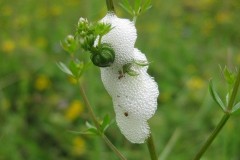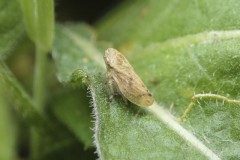School of Life Sciences, University of Sussex
We are planning a national survey of spittlebugs (aka froghoppers, cuckoo-spit insects) this coming season, asking people to record their sightings of ‘cuckoo-spit’ and the plant species on which they are found in April-June. Last year, we had a fantastic response from gardeners, coordinated through the RHS, recording spittle on their garden plants, especially lavender and rosemary. This year, we want to encourage records from more natural habitats in the wider countryside, so we are targeting the amateur naturalist community via LRCs and other natural history-focused organisations. Please contact us if you have any queries. We attach photos of the Meadow Spittlebug, Philaenus spumarius, and some spittle on Cleavers, but please contact us if you require other images.
Many thanks for your assistance.
Sincerely,
Dr Alan Stewart (a.j.a.stewart “at” sussex.ac.uk) and Dr Claire Harkin (C.Harkin “at” sussex.ac.uk)
School of Life Sciences, University of Sussex, Falmer, Brighton, BN1 9QG.
If you are interested in taking part please look at the survey so you know which information to collect. www.Spittlebugsurvey.co.uk
Did you know that the ‘cuckoo-spit’ that you see in spring is produced by the immature stage (nymph) of a spittlebug or froghopper? Once the nymphs emerge as adults, usually in late June, they leave their spittle ‘nest’ behind and become free-flying. There are ten species of froghopper in Britain. The so-called Meadow Spittlebug, Philaenus spumarius, is one of our commonest insects and has possibly the broadest diet of any insect, being known to feed on more than 400 species of plant.
Interest in these insects has recently been heightened by the fact that they all feed on the liquid contents of the plant xylem tissue and are therefore capable of transmitting the bacterium Xylella fastidiosa, that has recently been responsible for the death of millions of olive trees in southern Italy. Fortunately, the Xylella bacterium has NOT been found in the UK, but there is a danger that it could be accidentally introduced in imported plants (especially lavender, rosemary and olive trees).
We urgently need to understand better how the disease would spread if it were ever introduced into Britain. In particular, we need to map the geographical distribution of the different species of spittlebug and record the plant species that they feed on. Can you help? It would mean recording cuckoo-spit when you see it and especially the plant species on which you find it. Your plant identification skills will help us collect vital information. Please consider contributing to this important survey. Much more information and an online form for submitting your sightings can be found on our website at: http://www.Spittlebugsurvey.co.uk
Since Alan last contacted you, the Covid-19 lockdown has of course had a significant impact on the scope of our activities, so we have developed a couple of additional ‘lockdown-friendly’ resources that you might like to share with your members. We now have a lovely short video that talks about spittlebugs (nymphs only) and how to distinguish between genera:
https://youtu.be/anfH8DAC7p8
And a new family-friendly activity sheet with ‘fun facts’ about spittlebugs that will appeal to children, and an invitation for people to look for them in their gardens (or indeed local parks as the movement restrictions lift):
https://www.jic.ac.uk/app/uploads/2020/05/Spittlebug-activity-sheet-v2.pdf
As before, contributors can link directly to the survey form:
https://www.surveymonkey.co.uk/r/spittle2020
And our website supporting the survey includes species information, lots of images (mostly adults) and a blog focussed largely on fieldwork for the project:
https://www.spittlebugsurvey.co.uk/
I hope these new resources will be of interest to your members and would be happy to provide any other materials that might be useful.
All the best
Claire

